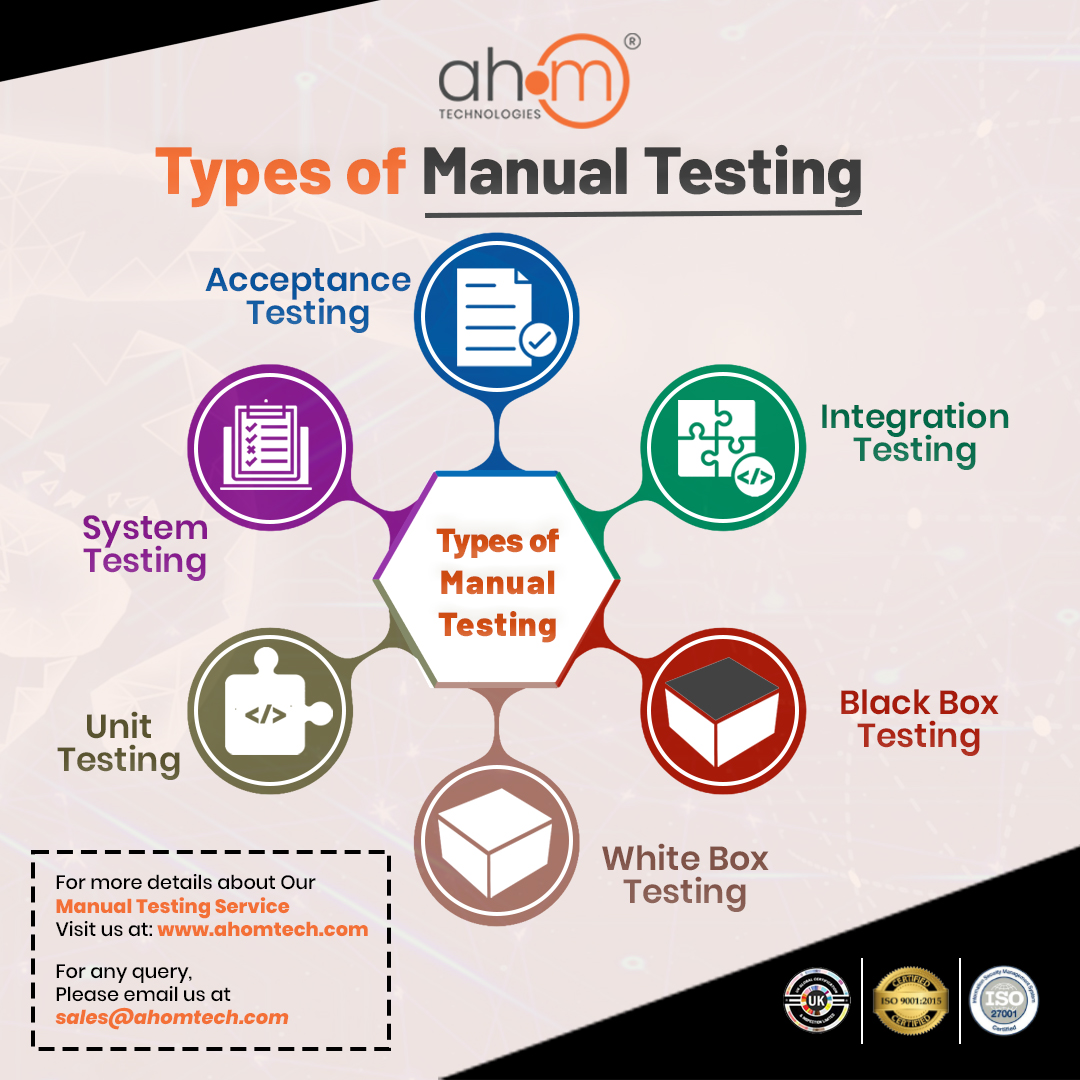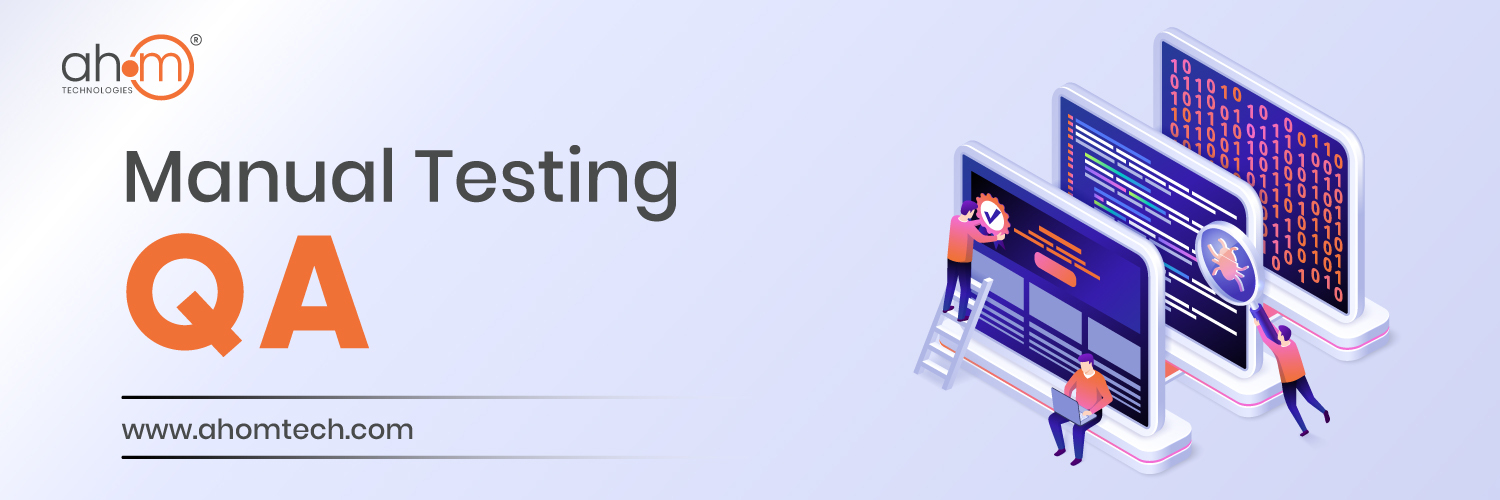Manual Testing is a type of software testing where testers manually execute test cases without using any automation tools. Manual testing is the most primitive of all testing types and helps find bugs in the software system of any new application.
Manual Testing requires more effort but is necessary before deciding on automation, it does not require knowledge of any testing tool,
One of the software testing fundamentals is that 100% automation is not possible; this makes manual testing an imperative goal.
The goal of Manual Testing is to ensure that the application is error-free and is working in a conformance to the specific functional requirements test Suites or cases.
Cases are designed during testing phase and should have 100% test coverage, it also makes sure that reported defects are fixed by developers and retesting has been reformed by testers on the fixed defects.
Basically this testing checks the quality of the system and delivers bug free products to the customer, manual testing types this diagram depicts.
Testing skill sets:
Testing requires many skill sets like myth testing ensures 100% defect free product,
Fact testing attempts to find as many defects as possible, identifying all possible defects is impossible, myth testing is easy, fact testing can be extremely challenging.
Testing an application for possible use cases with minimum test cases requires high analytical skills comparison of manual and automated testing.
Manual Testing requires human intervention for test execution, manual testing which will require skill labour,
Any type of application can be tested manually but automated testing is recommended only for stable systems and is mostly used for regression testing.
Testing is an activity where the tester needs to be very patient creative and open-minded they need to think and act with an end user perspective,
Let take a look at the topic in other way:
World of technology is completely dominated by machines and their behaviour is controlled by software powering. You guys know that any software project has three vital aspects that are cost, time and quality.
So the prime objective of any project is to get a high quality output while reducing the cost and the time required for completing the project but how is that achieved through software Manual testing?
Software Manual Testing is the face of development lifecycle that aims at evaluating the capacity of a program or a system or an application identifying its problematic areas and then determining if or not it meets the core objective of development.
So before software actually goes public programmers spend haas trying to iron out every little software bug they check for any mistakes and problems in the design and the functionality of the software.
Well until then product won’t be available for commercial use in the market so that’s what software testing is and it’s a part of software development lifecycle,
And very important part is that so this software testing is categorised into two main areas which are manual testing and automated testing,
While in manual testing as the names are just this case are executed manually by a human datas without any support from tools or scripts.
But with automated testing test cases are executed with assistance of tools, scripts and software.
Manual testing means testing of an application manually by a human a tester performing manual testing ensures that,
an application is working properly by following conditions:
Written in test cases this means that someone actually goes on a device to evaluate numerous components like design functionality and performance by clicking through multiple elements of the application.
Manual Testing Advantages:
Let’s take a look at a few of them with the manual testing,
Testers can test the application under similar conditions when the application goes live any bugs or glitches or errors,
Which occurs in the application’s life can be easily tracked with help of manual testing so we can call it life testing. manual testing less programming knowledge is required basically when you’re testing an application manually.
The main focus is on understanding the requirements documenting the test cases and executing test cases as you’re performing them as life so your focus and programming is usually less.
Manual Testing helps testers to identify any related to the look and feel of the application it also helps to find out the usability issues in the application and any bugs and defects that may pop up as soon as the user handles.
The given software in a certain way are more likely to be veg with help of manual testing so in case of visual testing, manual testing is really helpful,
It requires low investments and it doesn’t require any costly tools or high-level skills to perform so what I mean to say is that initial investment in manual testing is very low and manual testing is cost effective in short term scenarios.
Lastly in manual testing you can swiftly test and see the outcomes so it’s well suited in case when you’re making a lot of unplanned changes to your application of software.
An application needs to be tested immediately after implementing the changes in such cases manual testing is really helpful.
Know when to choose manual testing:
let’s take a look at few scenarios where you can apply this,
The first such scenario is exploratory testing. exploratory testing is carried out by domain experts so this type of testing requires testers knowledge, experience analytical skills, logical skills, creativity and intuition.
The test is characterized by poorly written documentation or a short time of execution so basically we need the human skills to execute the testing process in the scenario manual testing comes to rescue.
While working with poorly written documentation and if there is a shortage of that approach basically that exploratory testing requires minimal planning and maximum test execution which is possible.
If you choose manual testing, this is one scenario where manual testing is really helpful after you have used the ability , dusting usability testing helps to find out the user friendliness of an application.
As the name indicates, this is an area of value needed to measure how user-friendly, efficient or convenient the software or the product is to end-users so basically human observation is the most important factor so a manual approach is preferable.
Choose manual testing over automation testing when the project is usually in the initial development stage when testing user interface especially with visual aspects well,
If there’s a short term project mainly and the writing scripts will be time consuming in such cases you can use manual testing instead of going for automation
Procedure to Perform Manual Testing well:
Let’s take a look at it, the first step is understanding the requirements so in order to successfully conduct manual tests you first need to understand the requirements of the software.
So by understanding the requirements you will know what needs to be tested and what classifies as a defect or bug,
So that’s the crucial part of manual testing. The main goal here is to make sure that your software or application doesn’t have any bugs.
The next step is writing test cases so once you understand the requirements you can write test cases that’s another crucial part of manual testing.
These test cases basically guide you through a sequence of tests to test functions and different scenarios written within software applications and remember that writing good test cases is important.
The next step is conducting the test so once your test cases are written and test environments are properly prepared it’s time to begin testing. You can follow the test cases and mark each test has passed, failed or skipped.
Types of Manual Testing
 It’s basically divided into six types but again these types of testing can be carried out either manually or using a test automation – so
It’s basically divided into six types but again these types of testing can be carried out either manually or using a test automation – so
Let’s start with the first Types of Manual Testing
Black Box Testing:
The tester does not have any knowledge about the code or the structure of the application of software that is tested; he just interacts with the application and tests the functionality and the non-functional behaviour of the application.
Blackbox Techniques:
That can be used by the tester to find bugs and defects.
White Box Testing
As the name suggests in white box testing the tester knows about the code and the structure of the application for that reason it’s also known as glass box or transparent box testing.
Mostly this type of testing is used by developers to perform unit testing there are various white box testing that can be used by testifying bugs and defects,
Like have, control flow testing, data flow testing, branch testing and statement testing decision coverage and path testing and many more apart from black box and white box.
We have something called a grey box which hasn’t been listed here. It’s a part black box and it’s part white box
So basically we have information about certain factors of an application and we don’t have information about certain factors that we call grey box testing.
We have discussed all Types of Manual Testing and Stages of Manual Testing
in our previous session.
Let us consider those topics in detail in this session.
Unit Testing:
It’s a way of testing the smallest piece of code which is referred to as a unit. This unit can be logically isolated in a system well it is logically isolated in a system.
It’s mainly focused on the functional correctness of the standalone module.
It can be a specific piece of functionality it can be a part of your code or a program a particular method within the application it can be anything a unit,
So this unit testing uses white box testing methods or techniques and usually performs using a preferred programming language of your choice. It’s essential for the developers to unit test the software before handing it over to the QA team.
Integration Testing:
It is performed after unit testing where different units modules components of the software or the application.
Testing on is integrated or combined together as you can guess from the name itself the main purpose here is to verify the functionality stability and the reliability of the modules.
When they are combined together the main focus of integration testing is to check the correctness of communication among all these modules or units.
Steps after Integration Testing
It’s carried out on a complete fully integrated software product to evaluate the behaviour of the system in its entire fashion and then to examine how the full working of an integrated software computer system works against the given requirements.
So basically you are testing the entire application as a whole here so there are various system testing techniques here like you have functionality testing performance scalability stress testing and regression testing.
User Acceptance Testing (UAT)
User acceptance testing is the formal testing that’s performed based on user requirements and function processing.
It’s the last type of testing that needs to be done very correctly because it will provide you with the results on the basis of which your software product will either be approved or rejected by the senior management so it’s very important.
Final step is basically the entire manual testing is performed by humans so to repeat the same task again and again is really time consuming and there’s a high possibility of errors in manual testing.
That’s because manual testing is dependent on humans and there’s a high possibility of errors because the testing results will be as good as the test or performing the test.
So if the person who is performing the test is really good at what is doing then you can expect no errors otherwise you might find certain errors and bugs with manual testing there are chances that Testament miss out on some bugs or some repeated bugs.
Limitations of Manual Testing
which are resting within the application so what I’m trying to say here is that since – testing performed by humans it’s more prone to errors and then you have testing limitations.
When you begin testing one of the primary decisions that you will have to make is if you’re going to test your application of software manually or if you’re gonna apply automation well neither of these options are technically better or worse meant.
Compared to one another the features like size, budget and time allowance make a lot of difference on which one you are choosing so you should be aware of distinct and key differences between Manual Testing and automation testing.
So let’s end this session here as of now, we will continue it with another session on comparison of manual testing and automation testing and we will discuss automation testing in detail.
At Ahom Technologies, we are an expert professional QA Manual Tester with all these testing techniques and tools and technologies,
If you have any query regarding trial domain and services, please feel free to call us at +91-124 4294496 and contact us at www.ahomtech.com.



Add a Comment
You must be logged in to post a comment